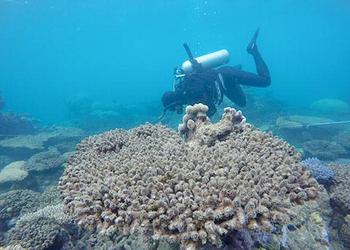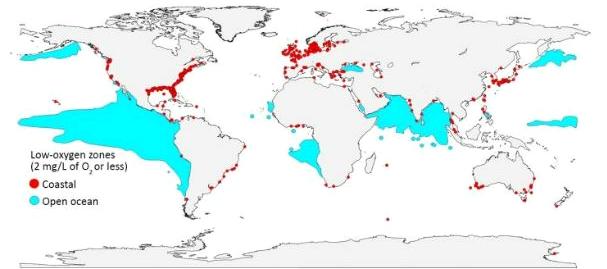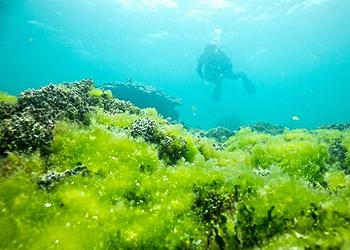
WASHINGTON, DC, January 8, 2018 (ENS) – The world’s coral reefs are dying due to global warming, finds a unique study published Friday in the journal “Science.”
For the first time, an international team of researchers measured the escalating rate of coral bleaching at locations throughout the tropics over the past four decades.

The study documents a shortening of the gap between pairs of bleaching events, threatening the future existence of these ecosystems and the livelihoods of many millions of people.
In a bleaching event, heat stress from record high summer temperatures damages the microscopic algae that live in the tissues of corals, turning them white. After they bleach, these stressed corals either slowly regain their algae and color as temperatures cool, or else they die.
“Reefs have entered a distinctive human-dominated era – the Anthropocene,” said co-author, Dr. C. Mark Eakin of the U.S. National Oceanic and Atmospheric Administration.
“The climate has warmed rapidly in the past 50 years, first making El Niños dangerous for corals, and now we’re seeing the emergence of bleaching in every hot summer,” said Dr. Eakin.
“The time between bleaching events at each location has diminished five-fold in the past three to four decades, from once every 25-30 years in the early 1980s to an average of just once every six years since 2010,” says lead author Professor Terry Hughes, director of Australia’s ARC Centre of Excellence for Coral Reef Studies, known as Coral CoE.
“Before the 1980s, mass bleaching of corals was unheard of, even during strong El Niño conditions,” said Hughes, “but now repeated bouts of regional-scale bleaching and mass mortality of corals has become the new normal around the world as temperatures continue to rise.”
The study, “Spatial and temporal patterns of mass bleaching of corals in the Anthropocene,” establishes a transition from a period before the 1980s when bleaching only occurred locally, to an intermediate stage in the 1980s and 1990s when mass bleaching was first recorded during warmer than average El Niño conditions, and finally to the current era when climate-driven bleaching is now occurring throughout ENSO cycles.
The researchers show that tropical sea temperatures are warmer today during cooler than average La Niña conditions than they were 40 years ago during El Niño periods of warm conditions in the tropical Pacific Ocean.
“Coral bleaching is a stress response caused by exposure of coral reefs to elevated ocean temperatures. When bleaching is severe and prolonged, many of the corals die. It takes at least a decade to replace even the fastest-growing species,” explained co-author Professor Andrew Baird of Coral CoE.
The Great Barrier Reef has now bleached four times since 1998, including for the first time during back-to-back events in 2016 and 2017, causing unprecedented damage. Yet the Australia government continues to support fossil fuels.
“We hope our stark results will help spur on the stronger action needed to reduce greenhouse gases in Australia, the United States and elsewhere,” said Hughes.
Also on Friday, “Science” published a separate scientific paper showing how the world’s oceans are losing oxygen – their breath of life.
In broadest view yet of world’s low oxygen ocean waters, scientists show that in the past 50 years, the amount of water in the open ocean with zero oxygen has gone up more than fourfold.
In coastal water bodies, including estuaries and seas, low-oxygen sites have increased more than 10-fold since 1950. Scientists expect oxygen to continue dropping even outside these zones as the Earth warms.
To halt the decline, the world needs to rein in both climate change and nutrient pollution, a separate international team of scientists asserted in the new paper.
“Oxygen is fundamental to life in the oceans,” said Denise Breitburg, lead author and marine ecologist with the Smithsonian Environmental Research Center. “The decline in ocean oxygen ranks among the most serious effects of human activities on the Earth’s environment.”
The study came from a team of scientists from the Global Ocean Oxygen Network, or GO2NE, a new working group created in 2016 by the United Nations’ Intergovernmental Oceanographic Commission.
The review paper is the first to take such a sweeping look at the causes, consequences and solutions to low oxygen worldwide, in both the open ocean and coastal waters.

The article highlights the biggest dangers to the ocean and society, and what it will take to keep ocean waters healthy and productive.
“Approximately half of the oxygen on Earth comes from the ocean,” said Vladimir Ryabinin, executive secretary of the Intergovernmental Oceanographic Commission that formed the GO2NE group.
“However, combined effects of nutrient loading and climate change are greatly increasing the number and size of ‘dead zones’ in the open ocean and coastal waters, where oxygen is too low to support most marine life,” warned Ryabinin.
In areas traditionally called “dead zones,” like those in Chesapeake Bay and the Gulf of Mexico, oxygen plummets to levels so low many animals suffocate and die. As fish avoid these zones, their habitats shrink and they become more vulnerable to predators or fishing.
But the problem goes far beyond “dead zones,” the authors point out. Even smaller oxygen declines can stunt growth in animals, hinder reproduction and lead to disease or even death.
Low oxygen also can trigger the release of dangerous chemicals such as nitrous oxide, a greenhouse gas up to 300 times more powerful than carbon dioxide, and toxic hydrogen sulfide.
While some animals can thrive in dead zones, overall biodiversity falls.

Climate change is the key culprit in the open ocean, the scientists say. Warming surface waters make it harder for oxygen to reach the ocean interior. As the ocean as a whole gets warmer, it holds less oxygen.
In coastal waters, excess nutrient pollution from land creates algal blooms, which drain oxygen as they die and decompose.
People’s livelihoods are on the line, the scientists report, especially in developing nations. Smaller, artisanal fisheries may be unable to relocate when low oxygen destroys their harvests or forces fish to move elsewhere.
In the Philippines, for instance, fish kills in a single town’s aquaculture pens cost more than $10 million.
Coral reefs, a key tourism attraction in many countries, can waste away without enough oxygen.
“It’s a tremendous loss to all the support services that rely on recreation and tourism, hotels and restaurants and taxi drivers and everything else,” said Lisa Levin, a co-author and marine biologist with the University of California, San Diego. “The reverberations of unhealthy ecosystems in the ocean can be extensive.”
The scientists advise that winning the low-oxygen war requires a three-pronged approach.
1. Address the causes: nutrient pollution and climate change. Better septic systems and sanitation can protect human health and keep pollution out of the water. Cutting fossil fuel emissions not only cuts greenhouse gases and fights climate change, but also slashes dangerous air pollutants like mercury.
2. Protect vulnerable marine life. With some low oxygen unavoidable, it is crucial to protect at-risk fisheries from further stress. The GO2NE team says this could mean creating marine protected areas or no-catch zones in areas animals use to escape low oxygen, or switching to fish that are not as threatened by falling oxygen levels.
3. Improve low-oxygen tracking worldwide. Scientists have a grasp of how much oxygen the ocean could lose in the future, but they do not know exactly where those low-oxygen zones will be. Enhanced monitoring, especially in developing countries, and numerical models will help pinpoint places most at risk and determine the most effective solutions.
“This is a problem we can solve,” Breitburg said. “Halting climate change requires a global effort, but even local actions can help with nutrient-driven oxygen decline.”
As proof, Breitburg points to the ongoing recovery of Chesapeake Bay, where nitrogen pollution has dropped 24 percent since its peak thanks to better sewage treatment, better farming practices and successful laws like the Clean Air Act. While some low-oxygen zones persist, the area of the Chesapeake with zero oxygen has almost disappeared.
“Tackling climate change may seem more daunting,” Breitburg said, “but doing it is critical for stemming the decline of oxygen in our oceans, and for nearly every aspect of life on our planet.”
Copyright Environment News Service (ENS) 2018. All rights reserved.
